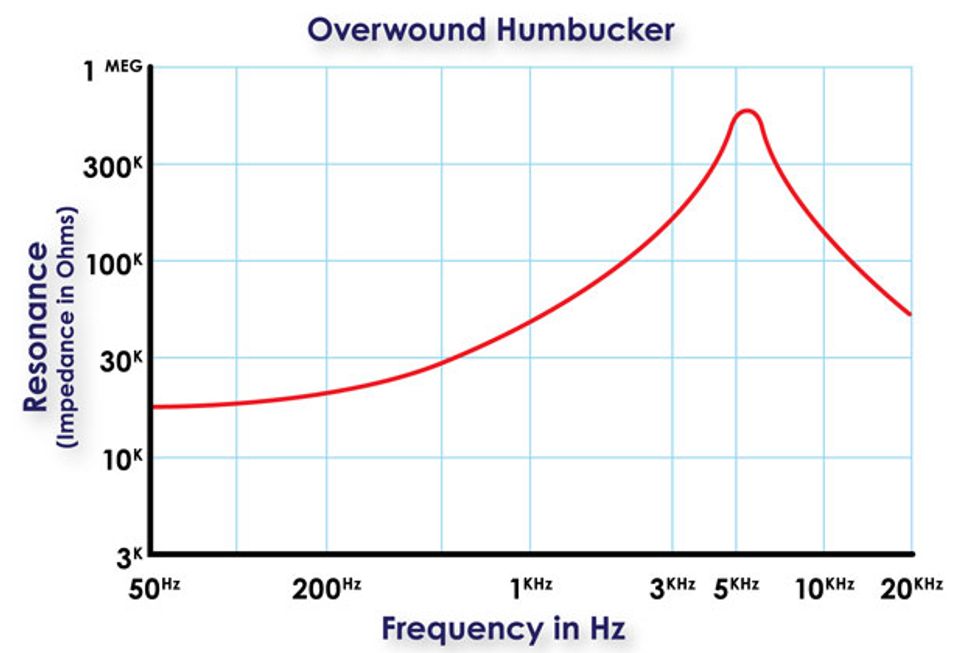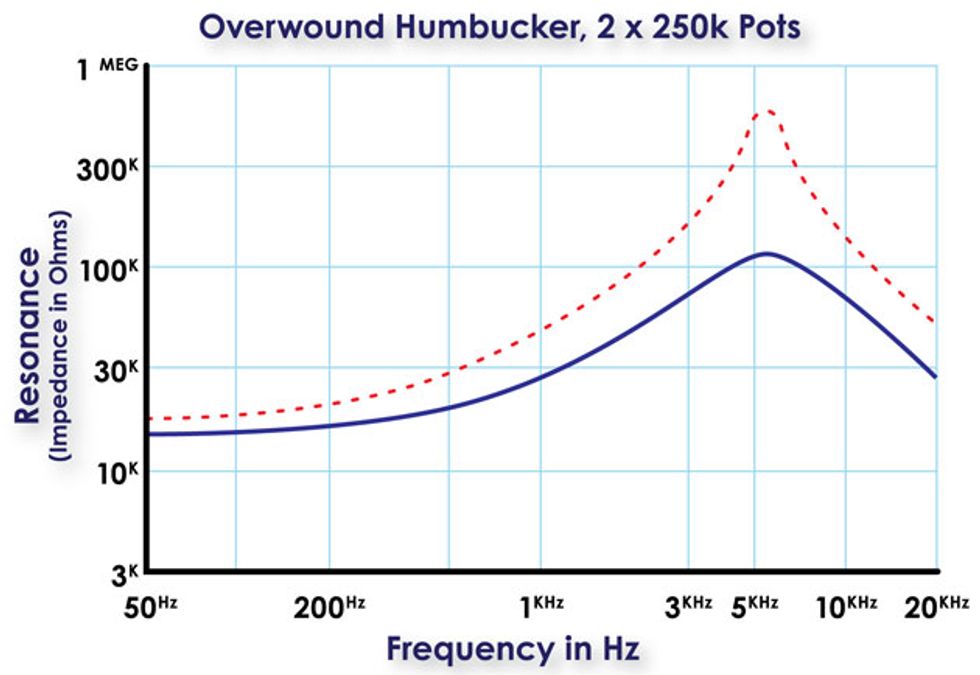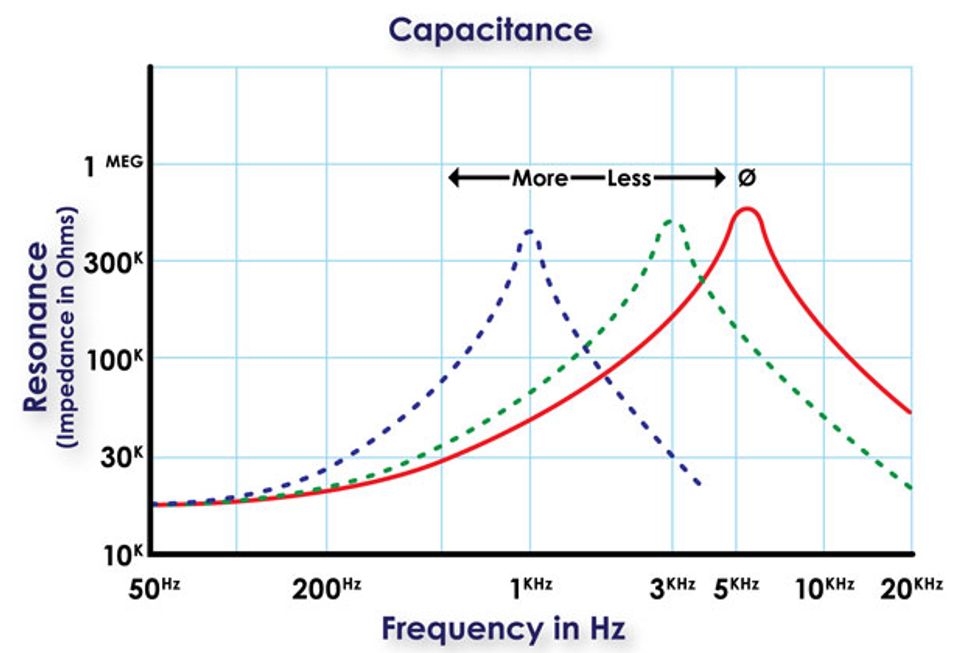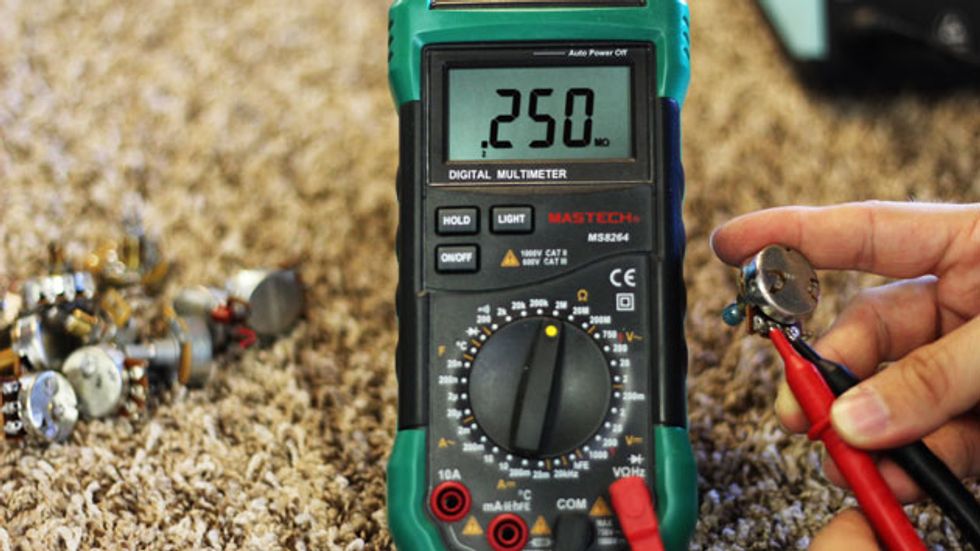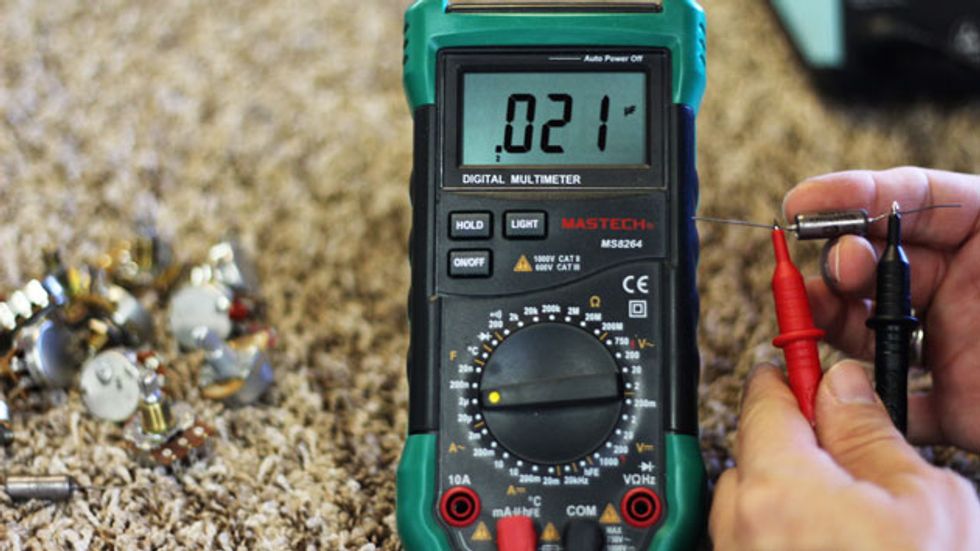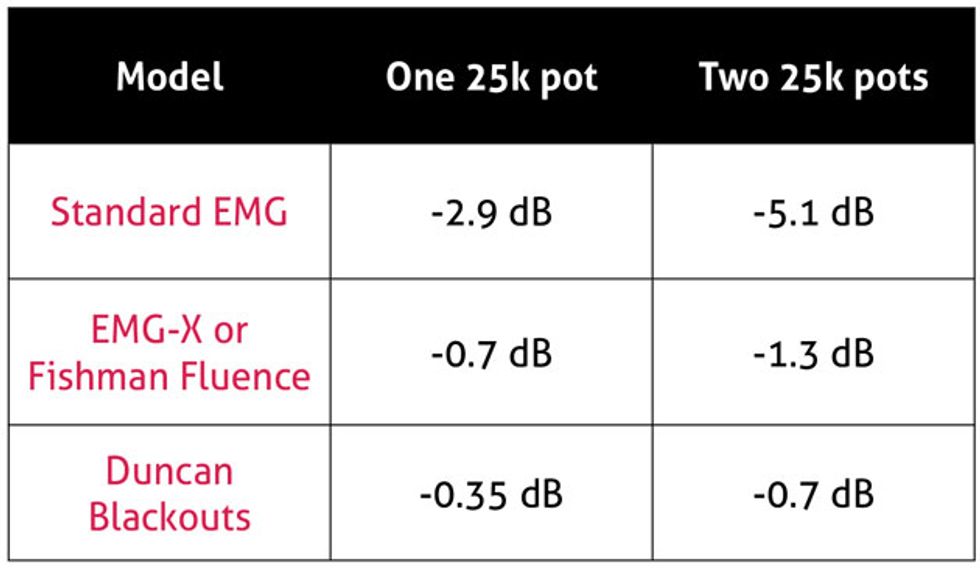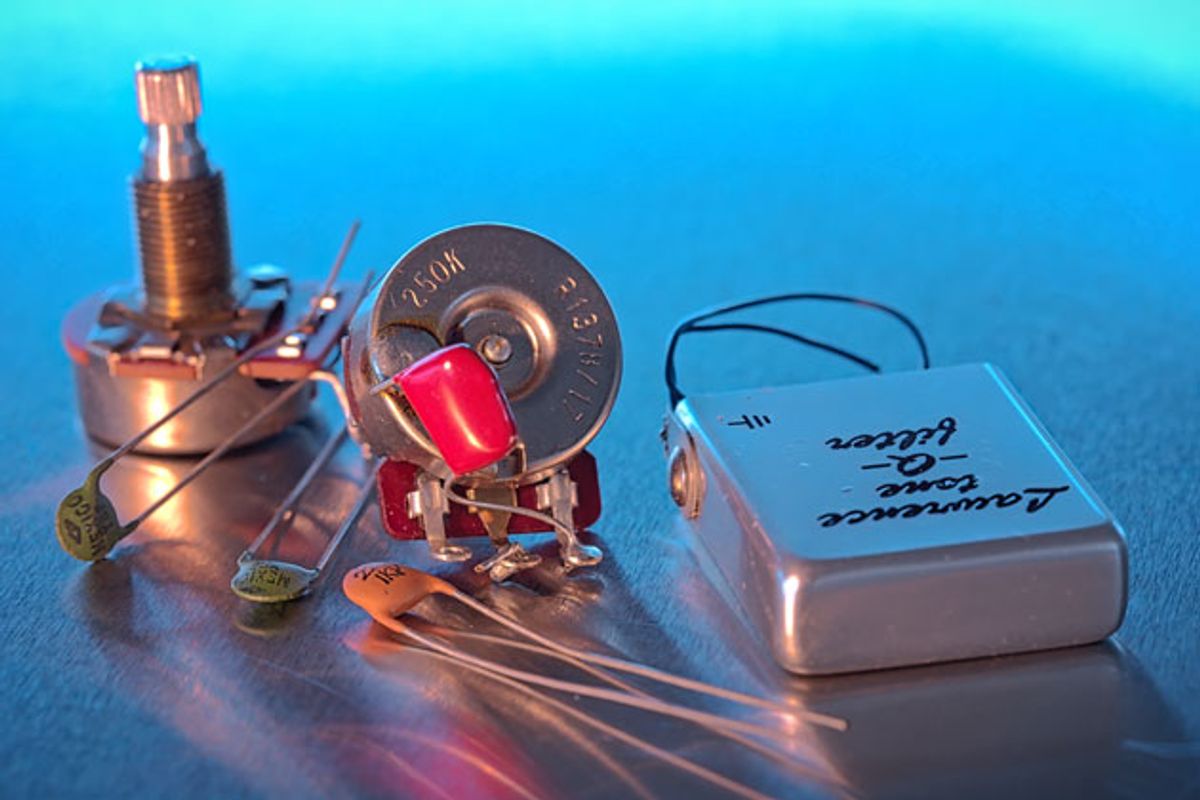
Pickup guru Frank Falbo on tweaking your guitar’s tone with nothing more than a soldering iron and a few components worth the change in your pocket.
Like it or not, there’s a deeply symbiotic relationship between your guitar’s pickups and its controls when you’re using passive pickups. That’s true even when your knobs are turned all the way up. It pays to understand how these components shape (or rather, complete) the sound of your pickups. Remember, the artisans who painstakingly designed your favorite passive pickups did so with pots, caps, and some guitar cable as part of the equation.
There’s a good chance your guitars still contain their original potentiometers and capacitors, and they may be perfect for you and your music. On the other hand, a bit of experimentation just may transform your guitars in ways that better suit your style and tastes. It’s not an expensive process, either—a good potentiometer costs about as much as a set of strings.
But experimenting blindly probably isn’t the best approach. This article explains how the parts in question affect your tone, and offers suggestions to try in pursuit of your ideal sound.
What We’re Not Discussing
We aren’t going to parse over different capacitor materials—only capacitor values. The internet is overrun with opinions on capacitor types, x-rays exposing tiny caps hidden inside bumblebee shells, and rants insisting that it’s impossible to play a convincing rendition of “Red House” without NOS caps dipped in quinoa oil and bong resin. (Don’t listen to that guy.) For demo purposes, I’ve used Russian paper-in-oil capacitors. If you prefer a different material, use caps of that type. But the comments here about relative capacitor values apply, regardless of cap material.
We’re also not discussing potentiometer types or tapers. (“Taper” refers not to a pot’s overall value, but the way the value is distributed across the shaft’s sweep.) Almost all guitar pots are audio taper (as opposed to linear or reverse-logarithmic), though some companies customize the sweep. Our focus here is how pots affect tone, even when they’re on 10.
The Fog of Tone
Much like a foggy day reduces visibility, or grease on the lens blurs your photo, resistance and capacitance filter your pickups. Actually, they go beyond that: In a way, they reach backward and shape the way the pickups resonate. Sometimes it’s in a good way, and sometimes not.
There are a tremendous number of variables that make your pickups sound the way they do—magnets, alloys, wire type and amount, and more. But there’s one universal thing that’s truly and directly impacted by your pots and caps: the pickup’s resonant peak.
Every passive pickup has an inherent resonant peak. It’s usually the pickup’s strongest frequency, since that’s where the coils resonate the most. In general, a single-coil’s peak is higher (more trebly) than a humbucker’s. When comparing otherwise equal pickups, a weaker, more underwound pickup’s peak is higher than a hotter, more overwound version. (As a pickup maker, I realize the vast chasm of detail I’m omitting for now, so bear with me, pickup superfans.)
Although a resonance sweep doesn’t truly represent a pickup’s overall frequency response, it’s a measurable response curve, and it looks something like Fig. 1.
Fig. 1
The slope from the bass is usually gradual, and then it peaks sharply, falling off fairly quickly after the peak. This is why a relatively low resonant peak generally coincides with a great deal of high treble loss. That age-old pickup maker’s adage—“I can make it a little hotter, but you’ll lose clarity”—is true at face value. At first glance, the curve looks a little like a wah-pedal sweep, with a big boost at the peak frequency. (A pickup’s resonant peak is not as pronounced as on a wah, but sometimes it helps to think of it like that.)
Take a PeakIf you take nothing else away from this article, know that the resonant peak frequency is generally the most identifiable component of your pickup’s tone. It’s what makes your pickup sound like your pickup, and not the next hotter or weaker model in the catalog. But your pickup probably wasn’t designed to be heard straight into the amp without any pots in line. The peak in the image above is very sharp. Here’s what that same pickup looks like with potentiometers attached to it (Fig. 2).
Fig. 2
Notice how the resonant peak is flattened. It hasn’t gotten bassier—you’ve just decreased the intensity of that resonant peak, which causes the sound to be a bit more homogenized. As we continue to increase the loading, passive pickups begin to sound more and more like each other as the characteristics that differentiate them are decreased.
Since most passive pickups resonate somewhere in the high midrange and treble frequencies, we’re often taught that lower-value pots “warm up” the sound and higher values brighten it, though not in the same way as a treble knob on an amp or EQ. (So don’t listen to the troublemaker who says “just turn the treble knob up/down on your amp.”)
How Capacitors Contribute
Unlike potentiometers, tone capacitors lower the frequency of the pickup’s resonant peak, as opposed to softening the existing peak frequency. It’s easy to explain tone capacitors as simply “rolling off treble.” An electrical engineer would say the capacitors combine with the resistance of the potentiometer to form a low-pass filter (that is, a filter that cuts treble).
Since the capacitors interact with the pickup’s coils, they lower the resonant peak frequency as you roll back the tone knob. Have you ever lowered your tone control to zero and felt like your guitar just got louder? How can that be if you’re taking frequencies away? Because the resonant peak frequency just descended into a more audible—and more energy-producing—range.
The higher the capacitor value, the lower the frequency. A larger-value cap creates a more muffled, bassy sound when rolled all the way off (Fig. 3). A smaller-value cap doesn’t lower the peak as much, and therefore leaves more treble intact. As you roll the tone knob down, your pickup “sees” more resistance and a gradual introduction of capacitance. Part of what you hear is the flattening of the pickup’s peak, much like when you roll the volume control down. The more you roll back the tone pot, the more you hear the full effect of the capacitance running to ground.
Fig. 3
Photo by Greg Marra
Who Uses What?
The rule used to be “use 250k potentiometers with single-coils and 500k pots with humbuckers.” But let’s play with that notion a bit.
Old Gibsons had 250k pots, but their humbuckers were relatively low output, with low DC resistance compared to modern rock and metal humbuckers. Let’s look at a higher-output humbucker: the iconic Seymour Duncan JB, which has a very aggressive high-midrange peak. With 500k pots it yields a screaming overdrive tone. But when Seymour himself uses one, it’s often with 250k pots, playing with his bare fingers. Wired and played this way, the pickup produces a thicker, stronger, warmer tone.
Vintage Stratocasters use 250k pots, but the vintage wiring scheme leaves the bridge pickup without a tone control. Other things being equal, the bridge-position pickup is even peakier than the neck and middle pickups. Many modern players wire a tone control to the bridge pickup, but this mellows the bridge pickup simply by being in the circuit—even if the tone control is all the way up! If your single-coil pickups seem dull and lackluster, try stepping up to 500k pots. (Or try “no load” pots, available from Fender and other manufacturers. When these pot are turned all the way up, the pot is effectively removed from the circuit. You hear your pickups as if they were wired directly to the guitar’s output jack.)
With Telecasters, things get interesting. Most Teles use 250k pots, though some are as high as 1 Meg. Capacitor values (and circuitry) vary wildly depending on the guitar’s date, and whether Fender used the so-called “dark” Tele circuit. If you aim to use your tone control to replicate some of the dark-circuit tones, you’ll have to match those capacitor values, one of which was a hefty .1 µF! Sometimes these caps were hard-wired into specific positions on the 3-way switch.
Instead of getting into the relative virtues of various vintage-correct wiring schemes, however, we’ll limit ourselves to sound clips of various cap values wired to a tone control in the usual way.
And how about stacked single-coils? There are many such designs, but in passive models the bottom coil always adds to the resistive load of the top coil. That’s why I usually like to use pots with values of 500k or more here. Stacked designs have already forfeited the sharp peak inherent in a true single-coil, and higher-value pots let the maximum peak get through.
About the Sound Clips
For all clips, I connected a short cable to a buffer (a Wampler dB+) and ran from there into a 1968 Fender Showman and a Naylor 12" speaker. For the dirty clips, I added two Wampler pedals, a Plexi-Drive and a Plextortion. (This may not be your favorite tone, but it highlights the differences well.) I used the buffer to best isolate the pots and caps. Depending on the first thing in your signal path—be it a germanium fuzz, various tube amps, or even a tuner pedal—you might find that certain pots and caps change the behavior of these devices as well. Since I can’t predict all of those variables, the buffer lets us focus on what’s actually coming out of the guitar, unaffected by downstream components. There’s a semi-clean, edge-of-breakup clip followed by a dirty clip, so you can hear how the peak (or lack thereof) influences the overdriven tone.
I’ve isolated the clips that demonstrate varying pot values from those showcasing different cap values. First comes the pot-value clip (the capacitor, a .022µf, is constant throughout, with the tone control always on 10). We start with no load, then 1 Meg, 500k, and 250k pots, always with the pots on 10. All the pots are ceramic Bourns 15-percent audio-taper models. The humbucker clips feature a Les Paul-style guitar with a Duncan Antiquity JB in the bridge and a Duncan Seth Lover at the neck. The Tele-style clips employ an ash/maple Tele with a stock Fralin Tele set (with a hybrid pole stagger).
Photo by Greg Marra
Comparing capacitor values in tone circuits (sweeping the tone control)
For the capacitor comparison, I’ve stuck with 500k pots so you can hear how various cap values affect the sound. The values are .047 µF, .022 µF, and .015 µF (plus a bonus .0015 µF on the Telecasters, upon Lindy's recommendation).
Comparing capacitor values in tone circuits (sweeping the tone control)
Frank, What Do You Like Best?
I’m flattered you’d ask! I’m a huge pickup fan. I have about 50 guitars, and almost none have duplicate pickups. I like to hear the differences—the character of each pickup. Even with weak single-coils I often use 500k pots. But if you’re not totally in love with the sound of your pickup(s), a 250k pot might deemphasize the characteristics you dislike, freeing you up to make different EQ choices on your amp and pedals.
What About Combining Values?
Pot resistance stacks up. When you have a 500k volume pot and a 500k tone pot, the pickup sees the equivalent of one 250k pot. Some players deliberately choose a 250k for volume and a no-load for tone. That way, the pickup only sees a 250k load, but the player still gets their desired taper. You could choose a 500k volume and 250k tone (or vice versa) in order to get the sound between those two values when both knobs are all the way up. You can also mix values in a Les Paul-type guitar. For example, you might mellow the bridge with 250k and sharpen the neck with 500k.
What About Active Pickups?
Some players believe that pot value doesn’t matter when using active pickups. True, changing pot values won’t alter the resonant peak as with passive pickups, but pot choice does affect your output level. For example, with standard EMG pickups you can forfeit as much as 5 dB of output by adding volume and tone controls.
With newer active pickups like EMG-X Series or Fishman Fluence models, the output doesn’t change as much when you add one or two 25k pots to the circuit. (For active pickups, 25k is the standard pot value.)
This table shows the approximate signal loss for various models when you add a pot or two.